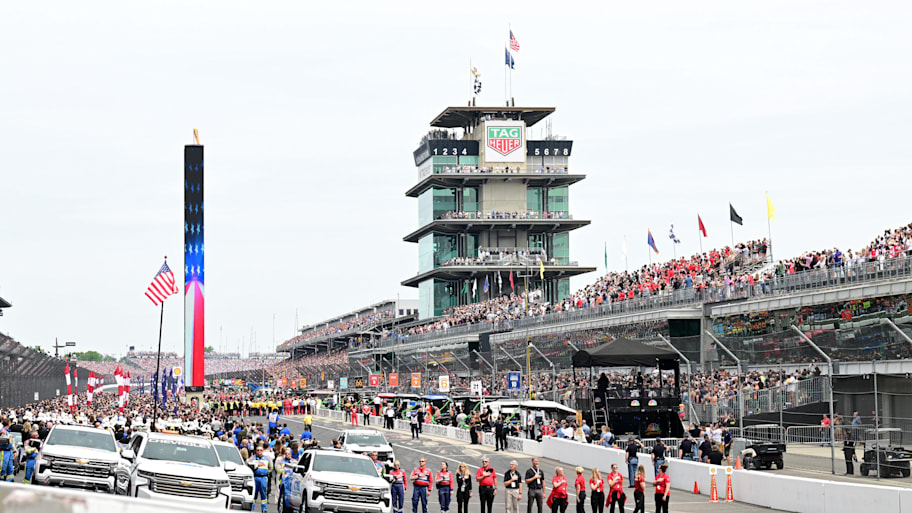The first thing you notice when you arrive at Indianapolis Motor Speedway is its size. Knowing that the track is two-and-a-half miles around isn’t enough to prepare you for how truly massive it is. The distance from one corner of the track to the other is roughly one mile, and the infield area covers a whopping 253 acres, big enough to simultaneously hold the White House, Vatican City, the Taj Mahal, the Roman Colosseum, Yankee Stadium, Rose Bowl Stadium, Liberty Island and Churchill Downs.
But that’s just the track. Including parking lots, the adjacent golf course and other miscellaneous land uses, the total size of the IMS property is 560 acres. By comparison, the golf courses that will host this year’s PGA Championship and U.S. Open—Quail Hollow and Oakmont—occupy a combined 461 acres.
The facility is too big for any fan to see all of it during a trip to one of the Speedway’s marquee races, but I got to see it all for this installment of Sports Illustrated’s “Stadium Wonders” video series. We got to go behind the scenes and see the garage areas, the control rooms, the luxury suites and, yes, the track itself.
IMS may feel enormous when you’re standing at the finish line, or on the roof of the control tower, but it begins to shrink quickly when you’re sitting in a speeding car going around the track. Producer Andrew Kristy and I got to hop in a pickup truck driven by Doug Boles, the president of IMS and of IndyCar, for a few laps around the track. Even traveling at highway speeds of a mere 75 mph, you can zip around the track in two minutes and suddenly the track is easier to grasp. Boles managed to get the truck up to 106 mph on our tour before the vehicle’s internal speed-limiting measures kicked in. That was plenty fast enough for me, but it obviously pales in comparison to what drivers do in races there. Drivers fly around the track at over 235 mph, covering the 2.5-mile distance—the same distance as from one end of New York’s Central Park to the other—in under 40 seconds. If it’s impossible for you to visualize that sort of speed, then the only solution is to sit in one of the speedway’s 257,327 seats and see it for yourself.
The reason IMS is famous—and the reason we wanted to feature it as part of Stadium Wonders—is its history. The track was built in 1909, making it the third-oldest speedway in the world and the oldest continuously operated auto racing track in the United States. And the biggest reminder of the track’s history is right there at the start/finish line: the famous yard of bricks.
When IMS was first built, the track was paved with a mixture of crushed stone and tar. But that surface quickly proved to be far too dangerous for autoracing. It became loose and unstable as the cars ran over it at high speeds and kicked up dust that made visibility dangerously low. On the first day of racing in August 1909, driver Wilfred Bourque and his mechanic Harry Holcomb were killed in a crash. Two days later, another mechanic, Claude Kellum, was killed when driver Charles Merz careened off the track in an incident that also killed two spectators. Shortly thereafter, IMS officials began paving the track with bricks.
It took 3.2 million bricks to cover the entire surface of the track, a monumental task accomplished in a mere 62 days. Over the years, the track was gradually paved with asphalt in spots where the bricks began to crumble, eventually leaving the final straightaway as the only brick portion. The 1961 Indy 500 was the last race run over the brick straightaway before it too was paved with asphalt, leaving only the famous three feet of bricks at the start/finish line as the last visible reminder of the track’s previous surface—the famed “brickyard” from which the track derives its nickname.
All those bricks are still under the track, though, and there are places where their presence is noticeable. Boles pointed out a couple of spots where the track buckled and dipped due to the bricks beneath and how they freeze and thaw at different rates each winter than the asphalt.
That’s just one of the fascinating details about the speedway that we learned during our trip there. For more on this historic venue, be sure to check out our full video. And keep your eyes peeled for more behind the scenes looks at the most interesting places in sports as we continue our Stadium Wonders series.
This article was originally published on www.si.com as Stadium Wonders: Inside Indianapolis Motor Speedway, the Home of American Auto Racing.
